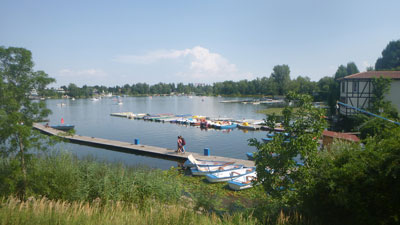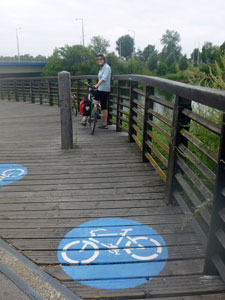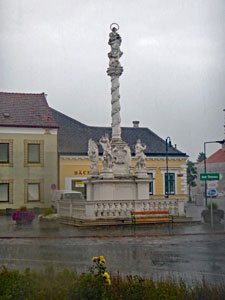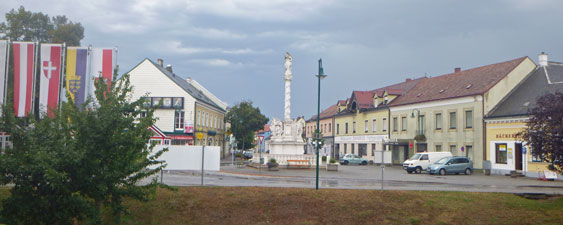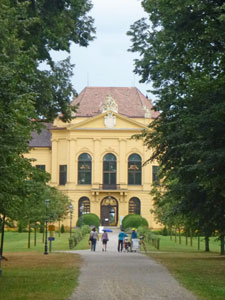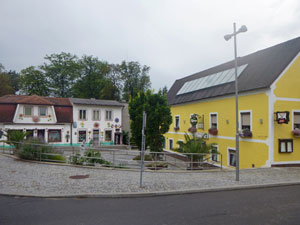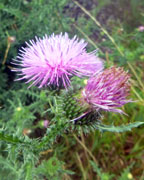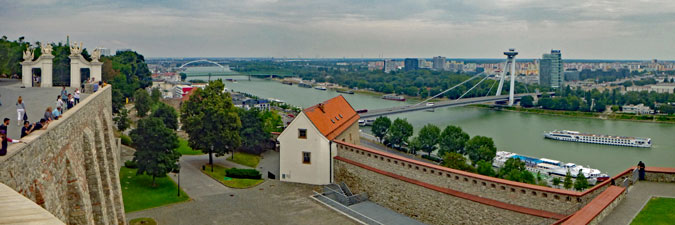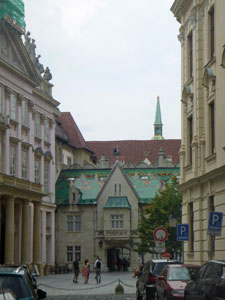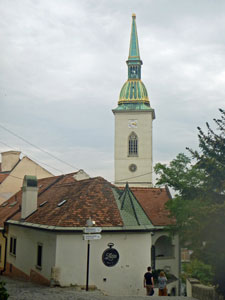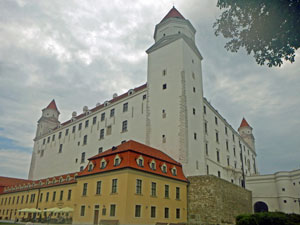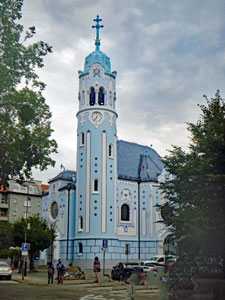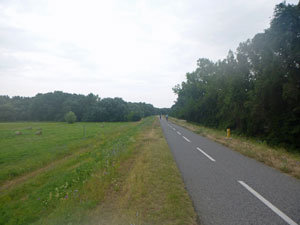| Danube Cycle Path - Vienna to Györ |
Getting There |
In the end, the night train from Frankfurt left at 3am (only three hours late due to the record European heatwave affecting track infrastructure). Despite our tiredness, it was hard to sleep in the hot and claustrophobic sleeper compartment with the carriage squeaking, groaning and clunking through the night. It will probably be our last overnight train trip. We reached Vienna just before lunch and caught the metro to our hotel in the modern UNO quarter of Vienna on the north of the main Danube branch. |
||
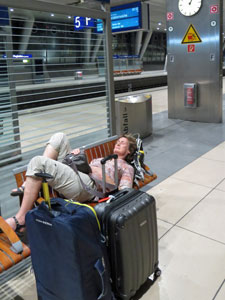 2am train wait at Frankfurt Bahnhof |
 The modern style of Vienna UNO |
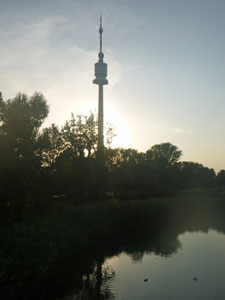 Viennese sunset |
Here we picked up our information packs and maps for the next seven days on the Danube cycle path. Five years ago, we had ridden from Passau in Germany along the Danube to Vienna and had enjoyed it so much that we were back to continue on to Budapest. Temperatures were still in the high 30s on the day we arrived, so there was not much to do other than hole up and recover from the train trip in the afternoon. As temperatures cooled later in the day, we joined the throngs of Viennese on their evening strolls through the riverside parklands that make this part of Vienna a pleasant place to live.
|
||
|
Day 1 - Vienna to Bad Deutsch-Altenburg (50 km) |
We were up relatively early to collect our bikes and panniers and, after depositing our bags at the pick-up point, we headed out into the coolish grey-skied weather - yes, the great European heatwave of July 2019 had broken and, as we headed north down one of the many urban cycle paths in Vienna, we were very pleased that it had done so. |
|
Conditions were very pleasant as we crossed the bridge over the Alte Donau, a long curving billabong that once was part of the Danube's flow. Now, as we rode along the riverside cyclepath of Eurovelo 6, we could watch the rowers gliding along its still waters, backed by the modern skyline of Vienna's UNO quarter. We were getting to know our bikes, well-geared and smooth to ride as we rolled along the Donau Radweg. |
The route continued along the main Danube channel, deviating slightly to pass an enormous oil refinery, before finally entering the region of the Donau-Auen National Park. This park preserves the forests and wetlands of the Danube floodplain, an area regularly inundated during high water flows. It was also where we felt the first drops of rain, and soon we were putting on our rain jackets as the sky darkened and a steady light rain set in. |
|
 Wetlands of the ...... |
 ....Donau-Auen National Park |
Not long after, the route detoured inland, passing through a lovely, if narrow, strip of floodplain forest, before crossing the dykes that prevent the flooding of the rich farmlands to the north. The flat landscape changed to cornfields and vegetable plantings, as we pushed our way steadily through the rain past the villages of Schönau and Mannsdorf - we had entered rain-riding rhythm, steady and focussed as we became increasingly damp. |
||
 A ride through the flood-plain forest .... |
 ... to the flat farmland, as the rain arrived |
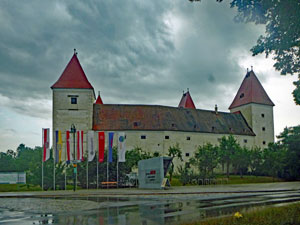 Storm approaching over Orth Castle |
|
Our eyes were on the lookout for a sheltered rest-stop, and it arrived in the form of a coffee shop in the village of Orth, just opposite the medieval Orth Castle in fact - timely, as peals of thunder had started to punctuate the darkening sky. We parked the bikes and headed in to enjoy a hot coffee - five minutes later the skies opened and the thunderstorm struck - we felt very lucky not to be out on the road.
|
Once the storm had passed, dragging all the rain with it, the sky lightened and we headed off again. Our route now was a dirt path across the flat farmlands, muddied by the rain, as we cycled into a warm and drying headwind. The route led straight to the former Imperial Hunting Lodge at Eckartsau - its bright yellow baroque architecture stood out in the dull light and proved a good spot to stop for a nice big slice of strudel and coffee. |
|
|
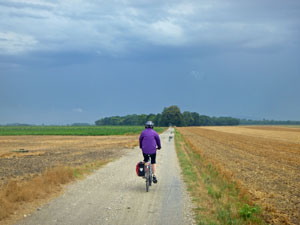 Following the storm |
 Entry to the Imperial Hunting Lodge |
|
Lunch over, we pushed on, now pedalling along a sealed road through the villages of Witzelsdorf and Stopfenreuth. At the latter, we detoured southwards through the floodplain forest to reach Au-Terasse on the northern bank of the Danube. From here we could look across to the hot-spring town of Bad Deutsch-Altenburg, our destination. We also had a chat with a park ranger, who told us of the history of this spot - an important river crossing since ancient times and where the Romans built the city of Carnuntum and a stone bridge across the Danube, as well as developing the iodine-sulphur springs. |
|
 The new bridge over the Danube |
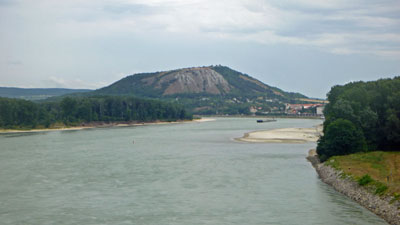 View down river from the bridge |
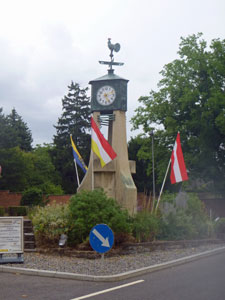 |
A little to the west lay the high modern steel-spanned Donau Bridge that now takes people across the river. The ranger gave us a tip to not retrace our path to Stopfenreuth to access the bridge, but to cycle a short distance along the old cobbled tow path and access it there. My German was good enough to understand that this would be much shorter, but not that we would need to carry the bikes up 6 flights of stairs to get to the bridge. Still, it saved us some time and soon we were across to the south bank and pedalling through the quiet streets of Bad Deutsch-Altenburg. |
|
A little further on, the bright yellow walls of our Gasthof welcomed us and we pulled in to park the bikes and end our first day of Danube Mark 2. Our luggage was there to greet us, as it would be at each stop on the trip. As we clinked our glasses over a hearty Austrian dinner later that evening, we agreed that, despite the rain, it had been a very good start to the trip. |
|
Day 2 - Bad Deutsch-Altenburg to Bratislava (21 km) |
The grey sky of yesterday had persisted overnight and greeted us in the morning, though the air was quite warm, as we retraced our route back towards the high Donau Bridge. This time we pedalled beneath it to follow the south bank of the river along a lovely tree-lined pathway that led to the neighbouring town of Hainburg. |
|
 Looking across the fields to the dome of Braunsberg |
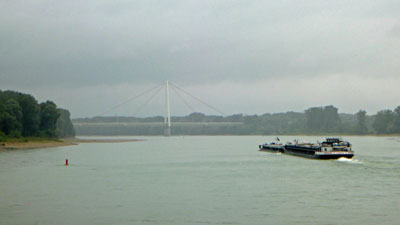 Barge heading up the Danube |
As we cycled along between the river and the rail, the first of several morning showers arrived. We donned our rain gear and headed on to our first climb of the trip, a steady rise up through the back streets of Hainburg to cross the saddle below the 340m domed hill of Braunsberg. |
||
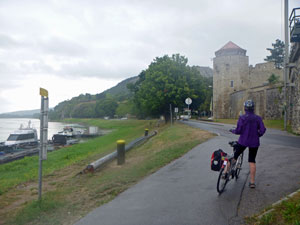 Riverside bike path at Hainsburg |
|
 View across the fields of Austria to Bratislava (Slovakia) |
|
|
 Sunflowers brighten up a rainy day |
|
|
At the saddle, we could see Bratislava and its castle on the far horizon, only 10 km as the crow flies but 15 km as the radweg meanders. It would be a short day of cycling, but that would give us time to explore Bratislava at our leisure. We cruised down the gentle slope, passing farmlands to follow the railway line, edged with summer wildflowers, that headed towards Slovakia. A couple more meanders down country lanes, and we arrived at Wolfsthal, the last village in Austria. |
||
 Wolfsthal - last village in Austria |
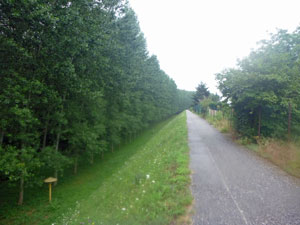 Bike path on the Danube levee |
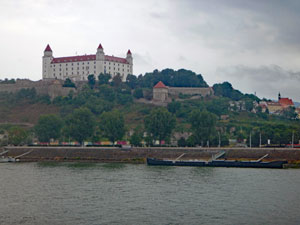 Looking across the river to Bratislava Castle |
Here, the showers finally stopped as we followed the Donau Radweg up onto the long flower-speckled levee bank that contains the floodwaters of the Danube. This swept around through open farmlands, seamlessly crossing the border - one minute Austria, the next Slovakia. As we cycled effortlessly across the border into Slovakia, we passed the crumbling infrastructure of the old border post - large buildings for customs, money exchange and passport clearances, police posts and long-lines of weed-infested parking places for vehicles and trucks. You could picture the frustration and expense of long waits for people and freight crossing the border. I couldn't help but think of the aftermath of Brexit - commiserations to all those Brits who voted to remain in the seamless European Union and to those brexiteers - well, tough titties, this is your future again.
|
The levee cycle path swept across the small enclave of Slovakia that lies south of the Danube to the imposing Novy Most Bridge, which led us high above the river to Bratislava and our hotel, just on the other side. It had only been a short stretch of cycling and we arrived by 10 am. However, with the sun now breaking through in patches, we had the rest of the day to explore the old centre of this historic city. |
|||
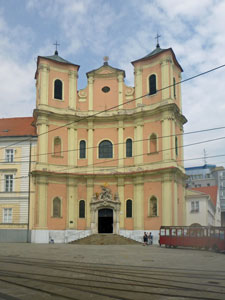 |
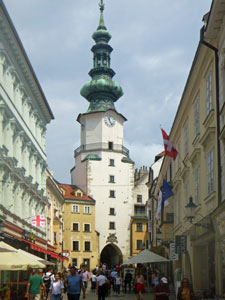 The streets and buildings ..... |
 ...of Old Bratislava |
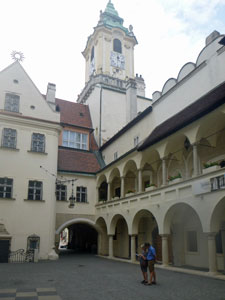 |
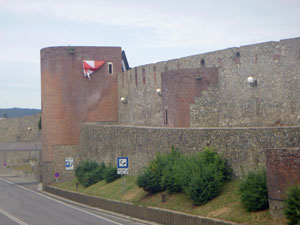 |
 |
 |
|
Thus, we wandered down its shady cobble-stoned boulevards, through narrow side-streets, archways and wide open squares, taking in the colours and architecture of its many public buildings and churches. Our walk culminated with a visit to Hrad Bratislavsky, the magnificently restored castle, perched high on a hill above the city and the river.
|
|
 The blue house |
 Slovakian bag-pipe band |
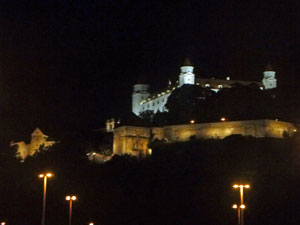 Night view of the castle (from our window) |
Bratislava may not be as well-known as some European cities, but it equals them in charm and the ease in getting around its smaller centre make it a pleasure to visit. Our day was capped off, as we took our post-dinner evening stroll down the boulevard, by a chance encounter with a Slovakian drum and bagpipe band marching through the old city streets - yes, my Scottish friends, you are not the only ones who have a tradition of playing bagpipes. |
||
|
Day 3 - Bratislava to Györ (51.5 km plus train) |
The front seemed to be taking its time to move on - though the sky was more grey-washed than threatening when we headed out from Bratislava. Quickly re-crossing the Novy Most Bridge, we turned east to follow the Donau Radweg along its levee top path. The map showed us following the south bank of the river, but in reality, river views were blocked by a dense band of forest. The pattern of the morning was set, a steady pace eastwards for the first 20 km, either on the levee or on the adjacent quiet country road that parallelled both levee and Danube channel. We were crossing the broad Danube floodplain, split by a series of anabranches and channels that drained the flat farmlands to its south. |
|
After 20 km, we noticed a road heading towards the river. We followed it, hoping to see the mighty Danube - we did and it was a surprise. the river had ballooned into a vast lake, held back by a series of gates between three narrow islands. At the end lay a private museum of modern art (not our cup of tea). We headed back to the little buffet at the crossroads for a break (and our cup of tea). This was also a stop for the big pelotons of lycra-clad Slovakian cyclists to have a beer and a smoke before continuing on their morning ride - to each his own. |
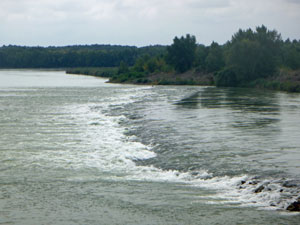 One of the few rapids on the middle Danube |
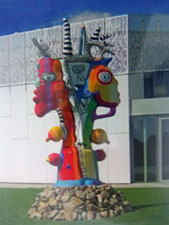 Modern art anyone? |
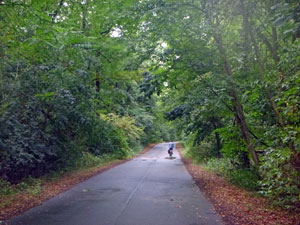 Beath the forest canopy in Hungary |
Refreshed, we pushed on, almost not noticing the fact that we had crossed into Hungary. Here, the road deviated away from the Danube, first passing through a section of lovely cool wetland forest, before breaking out into farmland with rolls of baled hay and fields of corn. |
||
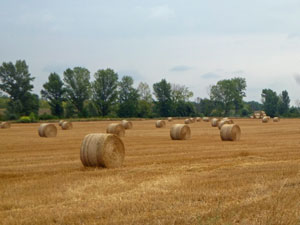 The Hungarian plain is a land of fields ..... |
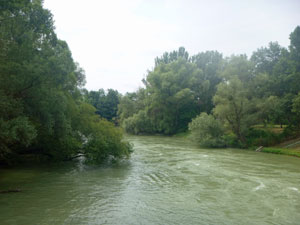 .... waterways .... |
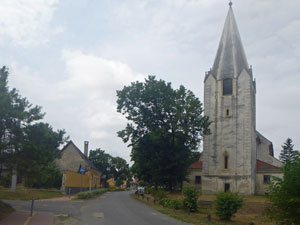 .... and quaint villages |
This brought us to the village of Rayka, where we were greeted by the rich aroma of piggery and bovine enterprise. Here we parted company with Eurovelo 6 and rode down the quiet back road to Dunakiliti, its main street lined with square tile-roofed houses and the obligatory steepled church at its heart. |
||
 Green fields near Rayka |
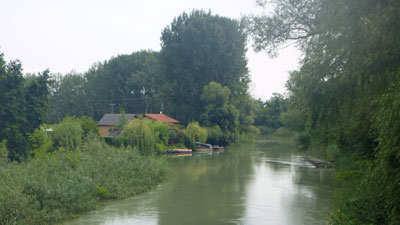 A peaceful anabranch of the Danube |
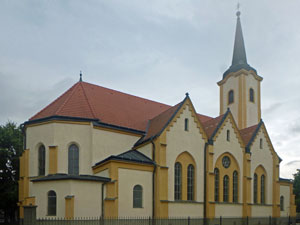 Church in Fekerteedo |
Farmland, forest and Danube River anabranches seemed to glide by, as we pushed steadily on along the road, passing through the little village of Fekerteerdo, before reaching the outskirts of the large rural town of Mosonmagyarovar. |
 The old houses of Fekerteedo |
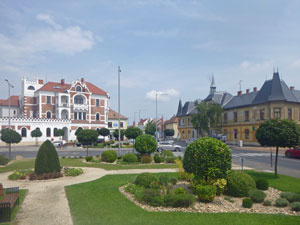 The town square of Mosonmagyarovar |
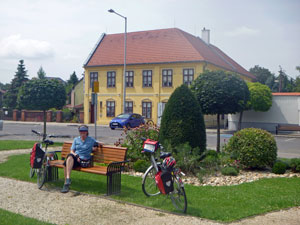 Rest stop in Mosonmagyarovar |
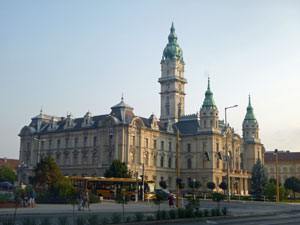 Municial buildings in Györ |
An exploration of the streets of this town finally brought us to the railway station at its southern edge. Our package included tickets to catch the train to Györ and we had arrived just in time ..... that is just in time to hear that our 14.37 train was delayed. In fact, the next train was the 12.36 to Budapest, only 1h30 late. We loaded our bikes and ourselves on board and, after three unannounced stops in transit, we finally disembarked in Györ to ride the short distance from train to hotel. |
 |
 Streetscapes in the old quarter ..... |
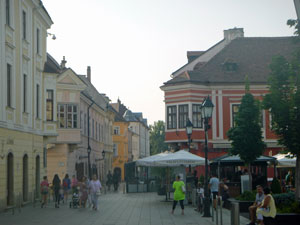 .... of Györ |
Györ is a large city (130,000 inhabitants) and consequently has a large modern shopping centre, which we visited to restock a few provisions before heading off to wander through the old city centre - some nicely restored Rennaissance-style civic buildings, with a touch of modern contemporary thrown in. The temperature had crept up today and was 30°C in the main square at 6pm - time to stop fo a mug of cold Soronyi beer at an outdoor cafe and watch the world go by. |
||
|



